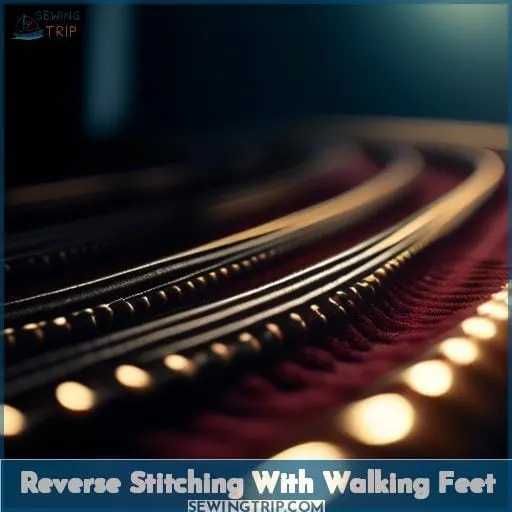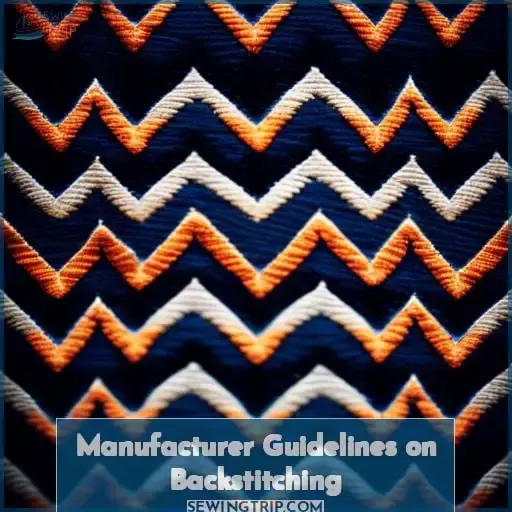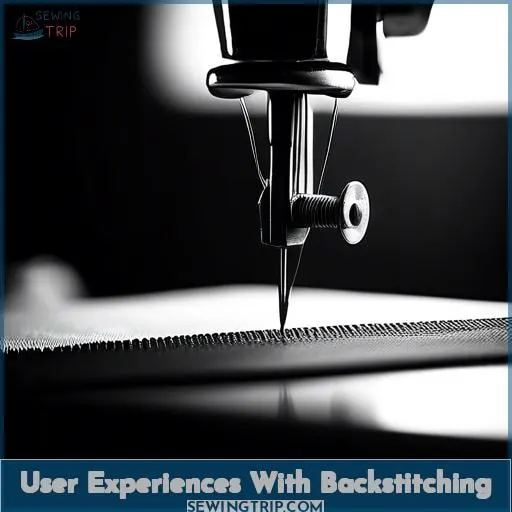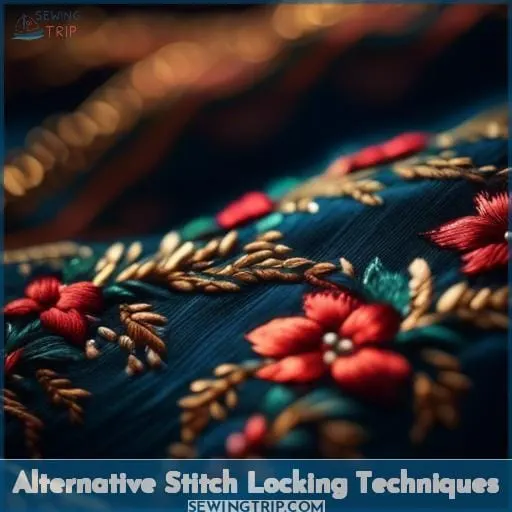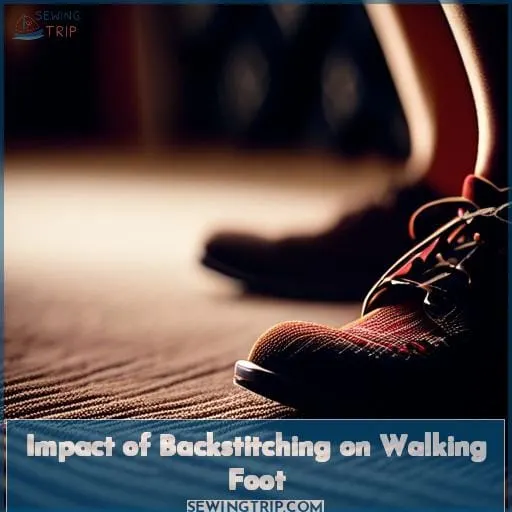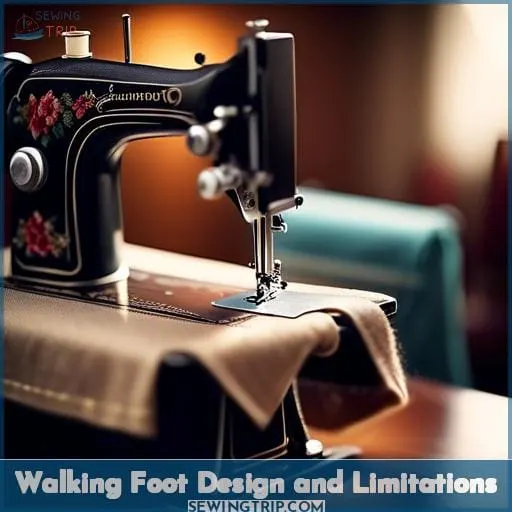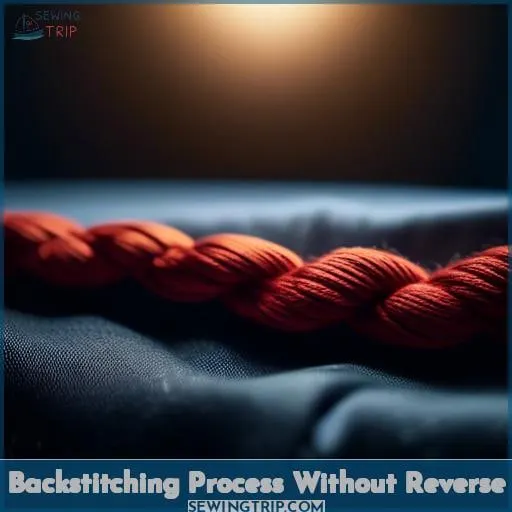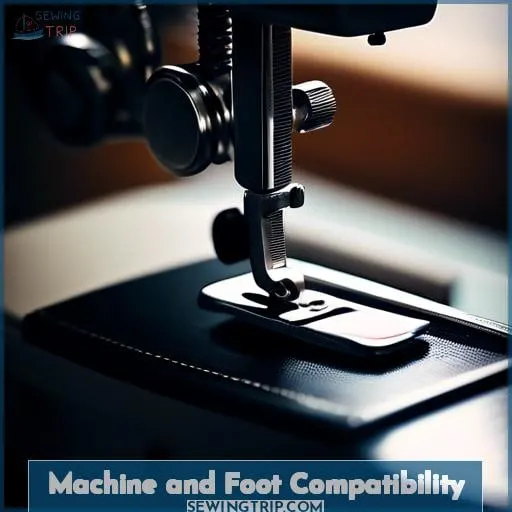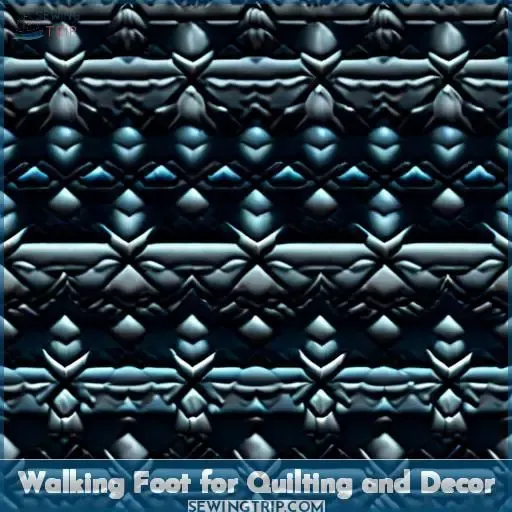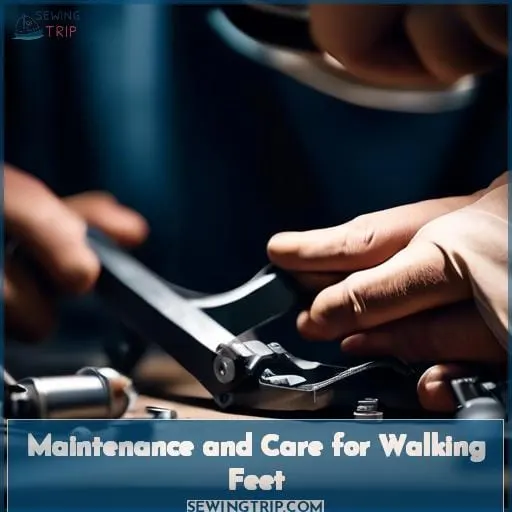This site is supported by our readers. We may earn a commission, at no cost to you, if you purchase through links.
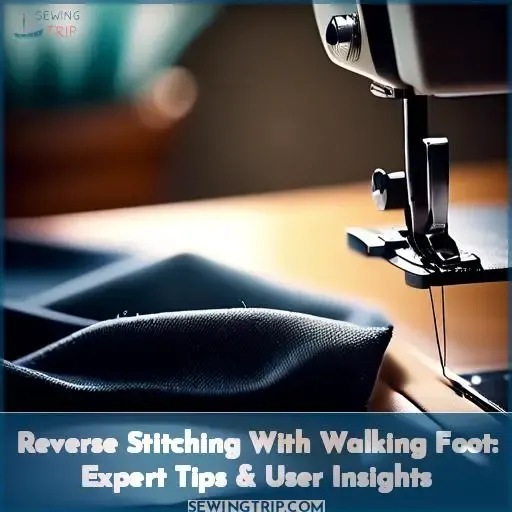
Whether you’re quilting a cozy blanket or crafting home decor, understanding the capabilities and limitations of your walking foot can make all the difference.
Some models, like Bernina, handle reverse stitching with ease, while others, such as Brother, advise against it.
Dive into the nuances of backstitching with a walking foot, and gain the confidence to master your sewing projects with precision and care.
Yes, you can reverse stitch with a walking foot, but it depends on the specific sewing machine and walking foot you are using. Some users report successfully backstitching with their walking foot without any issues, while others have experienced problems or have been advised against it by their machine’s manual.
It’s recommended to check your sewing machine‘s manual or consult the manufacturer to ensure that reverse stitching with a walking foot won’t damage your equipment.
Table Of Contents
- Key Takeaways
- Reverse Stitching With Walking Feet
- Manufacturer Guidelines on Backstitching
- User Experiences With Backstitching
- Alternative Stitch Locking Techniques
- Impact of Backstitching on Walking Foot
- Walking Foot Design and Limitations
- Backstitching Process Without Reverse
- Machine and Foot Compatibility
- Walking Foot for Quilting and Decor
- Maintenance and Care for Walking Feet
- Frequently Asked Questions (FAQs)
- Conclusion
Key Takeaways
- Compatibility and limitations for reverse stitching with a walking foot vary by sewing machine brand and model. Some manufacturers, like Bernina and Singer, allow reverse stitching, while others, such as Brother and Juki, advise against or prohibit it. Always consult the machine’s manual or manufacturer guidelines for specific instructions.
- User experiences with backstitching using a walking foot are mixed. While some users report successful backstitching without issues, others encounter noises or malfunctions. This underscores the importance of considering foot compatibility and machine limitations, and exploring alternative techniques to lock stitches if reverse stitching isn’t recommended.
- Backstitching with a walking foot can potentially lead to machine timing and alignment issues. Reports of noise and malfunction from some users, along with the fact that generic walking feet may not support reverse stitching, suggest that investing in a brand-compatible walking foot and avoiding excessive use of reverse stitching could prevent damage.
- Maintenance and care for walking feet are crucial for optimal performance. Checking the machine’s manual for specific instructions, testing foot movement before starting a project, and identifying stitch limitations for reverse stitching are recommended practices. Professional tune-ups can also help maintain smooth operation of the walking foot.
Reverse Stitching With Walking Feet
When working with a walking foot on your sewing machine, it’s important to know that some models, like those from Bernina, can perform reverse stitching within a specific range of smaller stitch sizes.
If you’re using a Singer walking foot, you’ll find it can also reverse without any hiccups.
Always refer to your machine’s manual to confirm the capabilities and limitations of your walking foot to ensure smooth operation and avoid potential damage.
Some Walking Feet Allow Reverse Stitching
When using a walking foot on your sewing machine, you might wonder about its reverse stitching capabilities. While some walking feet can handle reverse stitching, it’s essential to consult your manual or test the foot’s movement when it’s not attached to the machine.
For instance, the Bernina walking foot can reverse, but you should keep the stitch size within a specific range to avoid issues. Kim Jolly’s technique, which involves using a Baby Lock walking foot, includes making a few forward and backward stitches at the binding start and end for stitch locking, and many have used this method successfully.
However, be cautious with generic walking feet, as they may not be designed for reverse stitching, and using reverse could lead to breakage. Singer walking feet, on the other hand, are known to reverse without problems, offering a smooth experience.
Always remember to check your sewing machine’s manual for specific instructions regarding the use of the walking foot and backstitching to ensure you don’t damage your equipment or compromise your project.
Bernina Models Can Reverse With Smaller Stitches
When using Bernina models for your sewing projects, you’ll find that they can indeed reverse, but with certain limitations.
- Bernina walking feet are designed to handle reverse stitching, but with a smaller range of stitch sizes.
- Always refer to your machine’s manual for specific guidance on reverse stitching to ensure machine compatibility and avoid damage.
- Regular maintenance tips, such as oiling the foot and checking for wear, can help preserve the foot’s timing and function.
- For alternative techniques, consider using short stitches or sewing in place at the start and end of seams instead of reversing, especially with generic brands that may not be designed for reverse stitching.
These insights will help you master the use of your Bernina walking foot, ensuring control over your sewing projects and extending the life of your equipment.
Singer Walking Foot Operates in Reverse Smoothly
Transitioning from the nuances of the Bernina walking foot, you’ll find that the Singer walking foot offers a smoother experience with reverse stitching. This is a boon for quilters and home decorators alike, who rely on the walking foot for precise fabric handling.
Whether you’re adding stay stitching to a valance or reinforcing a quilt binding, the Singer walking foot manages reverse stitching without a hitch, aligning with manufacturer guidelines and ensuring the impact on your machine is minimal.
Here’s a table that encapsulates user experiences with the Singer walking foot:
| Feature | Singer Walking Foot | User Experience |
|---|---|---|
| Reverse Stitching | Operates smoothly | Positive feedback |
| Fabric Handling | Precise control | Enhanced quilting |
| Machine Impact | Minimal | Reliable performance |
Embrace the control and understanding that comes with a walking foot capable of reverse stitching, and let your creativity in fabric and quilting projects flourish without the fear of machine malfunctions.
Manufacturer Guidelines on Backstitching
When it comes to using a walking foot for reverse stitching, manufacturers’ guidelines vary, and it’s crucial to heed their advice.
Brother and Juki manuals caution against or outright prohibit backstitching with a walking foot, suggesting potential damage or malfunction.
On the other hand, Janome and Pfaff machines are more accommodating, allowing for backstitching with their walking feet, which can be a significant advantage for certain sewing projects.
Understanding these guidelines can help you avoid unnecessary wear on your equipment and ensure your sewing projects turn out as intended.
Brother Advises Against Backstitching With Walking Foot
While some sewing enthusiasts have successfully used their walking foot for reverse stitching, Brother advises against backstitching with a walking foot. This guidance stems from the design of the walking foot, which is optimized for forward movement to ensure even feed during sewing.
Attempting to reverse stitch can lead to foot malfunction, potentially affecting stitch quality and machine compatibility. To secure your stitches at the beginning and end of seams without risking damage, consider alternative techniques.
For instance, starting with a few small, tight stitches can lock the thread in place effectively.
This approach aligns with user preferences for maintaining project integrity without compromising their equipment.
Juki Prohibits Backstitching With Walking Foot
When using a Juki walking foot, it’s crucial to adhere to the manufacturer’s guidelines to avoid potential damage to your machine.
- Manual Guidance: Juki’s manual may not explicitly mention backstitching, but user experiences suggest it’s best avoided.
- Reverse Limitations: Attempting to reverse or backstitch can lead to a groaning noise, indicating strain on the foot or machine.
- User Preferences: While some users have backstitched without issues, Juki recommendations lean towards caution to prevent damage.
- Walking Foot Compatibility: For specific stitches like the lightning stitch, three-step zigzag stitch, triple stretch stitch, or overcasting, ensure your walking foot is compatible to avoid mishaps.
Janome and Pfaff Machines Permit Backstitching
Continuing from the discussion about the limitations of backstitching with certain walking feet, it’s important to note that not all sewing machine brands have the same restrictions. If you’re using Janome or Pfaff machines, you’re in luck. These brands have designed their walking feet to handle backstitching, giving you more flexibility in your sewing projects.
This compatibility is a testament to the quality of Janome and Pfaff walking feet, which are tailored to meet the needs of sewists who demand reliability and precision.
Here’s a quick comparison of walking foot compatibility and quality across different sewing machine brands:
| Sewing Machine Brand | Backstitching Capability |
|---|---|
| Janome | Permits backstitching |
| Pfaff | Permits backstitching |
| Brother | Advises against |
| Juki | Prohibits backstitching |
User Experiences With Backstitching
When it comes to reverse stitching with a walking foot, user experiences vary.
Some sewers have successfully used the backstitch function without any issues, while others have encountered noises or even malfunctions.
It’s important to consider these mixed outcomes and proceed with caution, as the walking foot is typically designed to move in a forward direction only.
Varied Results Among Users
As you delve into the world of sewing, you’ll find that user experiences with backstitching using a walking foot can vary widely. While some sewers report smooth sailing, others encounter groaning noises or even malfunctions.
It’s crucial to consider foot compatibility with your machine, as not all walking feet are designed to handle reverse stitching. Your user preferences, the stitch quality you’re aiming for, the thickness of your fabric, and the type of seam finishing you need are all factors that can influence the success of backstitching with a walking foot.
Always check your manual for guidance and remember that alternative techniques, like starting with tight stitches and gradually increasing length, can lock stitches without backstitching.
Some Report Successful Backstitching
While some users tread cautiously with limited reverse stitching, others, like those employing the Kim Jolly technique with a Baby Lock foot, report success.
This method involves a few forward and backward stitches at the start and end of binding, showcasing the adaptability of certain brands.
Bernina foot capability allows for reverse stitching, albeit with restrictions, contrasting with the more rigid limitations of generic feet.
Others Encounter Noises or Malfunctions
While some sewists have successfully used backstitching with their walking foot for added security at the start and end of seams, others have encountered issues.
Notably, Elaine experienced a concerning groaning noise from her Juki walking foot during backstitching, audible even from other rooms. This issue isn’t isolated; various users have reported similar problems, including malfunctioning walking feet and seam separation.
These incidents underscore the importance of adhering to manufacturer guidelines, which often advise against backstitching with walking feet due to the potential for damage or malfunction.
For those seeking alternatives, techniques such as starting with tight stitches and gradually increasing stitch length can effectively lock stitches without the need for reverse stitching. This approach, along with regular maintenance and adherence to specific machine instructions, can help mitigate the risk of walking foot issues while ensuring seam security.
Alternative Stitch Locking Techniques
When you’re looking to secure your stitches without backstitching, consider gradually increasing your stitch length at the start. This method locks the stitches effectively and avoids the potential seam issues that can arise from reverse stitching with a walking foot.
It’s a practical alternative that combines technical sewing knowledge with the need for a durable finish.
Gradual Stitch Length Increase for Locking
When you’re aiming to lock your stitches without backstitching, consider starting with a shorter stitch length.
As you sew, gradually increase the stitch length to your desired setting. This method is particularly useful when working with varying fabric thicknesses or when managing the presser foot pressure and seam allowance.
Adjusting stitch tension may also be necessary to ensure your stitches are even and hold well. Remember, the goal is to achieve a strong seam without the need for reverse stitching, which can sometimes cause issues with walking feet.
Avoiding Backstitching to Prevent Seam Issues
Continuing from the discussion on starting with tight stitches to lock them, let’s delve into why you might want to avoid backstitching with your walking foot. Manufacturer warnings and user experiences suggest that backstitching can lead to seam separation and noise issues.
- Begin with very short stitches to secure the seam start.
- Gradually increase stitch length to lock without reversing.
- Use fray check or fabric glue to secure seam ends.
- For decorative topstitching, tie off threads by hand.
- Consult your machine’s manual for specific recommendations.
These methods can help maintain the integrity of your seams and prevent potential damage to your walking foot.
Impact of Backstitching on Walking Foot
When considering the use of a walking foot for reverse stitching, it’s crucial to understand the potential impacts on your sewing machine.
Some users have reported issues like noise and malfunction after attempting reverse stitches with their walking foot, suggesting that not all walking feet are designed to handle reverse stitching effectively.
It’s advisable to consult your machine’s manual or test the walking foot’s movement when detached from the machine to ensure it can move freely in reverse without causing damage.
This approach combines practical experience with technical knowledge to help you make an informed decision about reverse stitching with a walking foot.
Potential for Machine Timing and Alignment Issues
When it comes to backstitching with a walking foot, it’s crucial to understand the potential for machine timing and alignment issues.
This isn’t just about keeping your foot’s longevity in check; it’s about ensuring the overall health of your sewing machine.
Thread tension, needle size, fabric choice, and stitch gauge play significant roles in this dynamic.
If you’re not careful, reversing with a walking foot can lead to misalignment or even damage, affecting the machine’s performance.
It’s a delicate balance, where the right settings and understanding of your machine’s capabilities can prevent unnecessary wear and tear.
So, always consider these factors to maintain your sewing machine in top condition.
Noise and Malfunction Reports From Some Users
Continuing from the previous discussion on the potential issues that backstitching can cause with walking feet, it’s important to note that some users have reported noise issues and malfunction concerns when attempting to backstitch.
These user experiences highlight the impact on the foot, which can range from audible groaning noises to complete malfunctions where the foot ceases to move. Manufacturer advice often cautions against backstitching with walking feet, as seen with Brother and Juki.
It’s crucial to heed these warnings to avoid damaging your machine and to explore alternative stitch locking techniques that can secure your work without the risks associated with backstitching.
Walking Foot Design and Limitations
When exploring the capabilities and limitations of walking feet, especially regarding reverse stitching, it’s crucial to understand that not all walking feet are created equal.
Generic walking feet may lack the design and durability to support reverse stitching effectively, leading to potential damage or malfunction.
On the other hand, brand-specific walking feet often offer higher quality and may accommodate reverse stitching with fewer risks, though limitations still apply.
This distinction underscores the importance of consulting your sewing machine’s manual and considering the investment in a brand-compatible walking foot for optimal performance and longevity.
Generic Feet May Not Support Reverse Stitching
When you’re eyeing those budget-friendly generic walking feet, tread carefully. These cheaper alternatives mightn’t be engineered for reverse stitching, leading to potential mishaps.
It’s not uncommon to hear tales of a cheap foot malfunctioning or even breaking due to reverse use damage. This issue underscores the importance of quality impact on your sewing experience.
Durability concerns with generic feet are real; they may save you money upfront but could cost you more in repairs or replacements down the line. Always weigh the quality against the price to ensure your sewing projects run smoothly without unexpected interruptions.
Quality Differences Between Brand and Generic Feet
When considering a walking foot for your sewing machine, you’ll find that brand-name options often offer better quality and foot compatibility compared to generic versions.
While the upfront cost of a branded foot may be higher, the price comparison over time can reveal the value in terms of durability and performance.
Generic feet might be tempting due to their lower price, but they may not be designed to withstand extensive use or reverse stitching, potentially leading to malfunctions or damage to your machine.
It’s wise to invest in a walking foot that matches your machine’s brand to ensure seamless operation and longevity.
Backstitching Process Without Reverse
When working with a walking foot on sewing projects that require backstitching but lack reverse functionality, you’re not out of options.
For a backstitch effect, you can manually rotate your fabric after lifting the presser foot, allowing you to sew over the beginning or end of your seam for secure stitching. This technique is particularly useful on treadle machines or older models without built-in reverse capabilities.
By understanding and applying these methods, you ensure the durability of your seams without the need for reverse stitching.
Manual Fabric Rotation for Backstitch Effect
When you’re faced with machine limitations or seeking alternative techniques for securing your stitches, consider the manual fabric rotation method. It’s a tried-and-true approach that echoes the ingenuity of user experiences and maintenance tips from the past.
- Begin by sewing forward to the desired point and stop with the needle down.
- Lift the presser foot and rotate your fabric 180 degrees.
- Sew forward again, effectively creating a reverse stitch.
- Repeat the lift and rotate steps to continue sewing in the original direction.
- This technique ensures your seam ends are secure, even on treadle machines.
Treadle Machines Require Manual Back Stitching
When working with treadle sewing machines, you’ll find that manual back stitching is a necessity since these machines lack the reverse feature found in modern machines. To secure your stitches at the beginning and end of a seam, you’ll need to manually rotate your fabric.
This process involves sewing a few stitches, stopping with the needle down, lifting the presser foot, and carefully turning the fabric 180 degrees to sew back over the stitches you just made.
| Step | Action | Note |
|---|---|---|
| 1 | Sew initial stitches | 2-3 stitches forward |
| 2 | Needle down, lift foot | Prepare to pivot fabric |
| 3 | Rotate fabric 180° | Carefully, to avoid needle strain |
| 4 | Sew back over stitches | Locks the seam in place |
| 5 | Repeat at seam end | Ensures a secure finish |
This technique is a practical alternative to the machine back stitch and is essential for maintaining the integrity of your seams, especially when working on projects that can’t accommodate back stitch avoidance or other back stitch alternatives.
Remember, mastering manual back stitch techniques like the treadle back stitch can give you greater control over your sewing projects and contribute to your overall sewing mastery.
Machine and Foot Compatibility
When exploring the compatibility of your sewing machine and walking foot for reverse stitching, it’s crucial to first consult your machine’s manual for specific instructions. Manufacturers often provide detailed guidance on what your machine and its accessories can handle.
If the manual doesn’t answer your question, reaching out to customer service can offer personalized advice and solutions. This approach combines practical experience with technical knowledge, ensuring you get the most accurate and helpful information for your sewing projects.
Importance of Checking the Manual for Instructions
When using a walking foot on your sewing machine, it’s crucial to check the manual for specific instructions. Manufacturers often provide guidelines on whether a walking foot can perform reverse stitching, and these can vary between models and brands.
- Check compatibility: Ensure your walking foot is designed to work with your machine model.
- Test foot movement: Before starting your project, test how the walking foot operates in reverse.
- Identify stitch limitations: Some walking feet may allow reverse stitching only with certain stitch lengths or types.
- Explore alternative techniques: If reverse stitching isn’t recommended, look for other methods to secure your stitches.
- Avoid excessive use: Even if reverse stitching is possible, doing it sparingly can prevent potential damage to your walking foot.
Customer Service as a Resource for Guidance
When you’re delving into the specifics of your sewing machine, especially when it comes to using a walking foot for reverse stitching, it’s crucial to consult the manufacturer’s guidelines.
If you hit a snag or the manual falls short, customer service can be an invaluable resource. Brother’s customer service, for instance, is known for its excellence and can provide personalized guidance to ensure your machine operates correctly.
They can clarify whether your model supports reverse stitching with a walking foot and help troubleshoot any issues you might encounter.
Walking Foot for Quilting and Decor
When working on home decor projects like curtains or quilting designs, you might wonder if you can secure your stitches by backstitching with a walking foot.
While some sewing machines, like certain models from Janome and Pfaff, allow backstitching with a walking foot, others, such as Brother and Juki, advise against it or prohibit it due to potential damage to the foot or the machine.
It’s essential to consult your machine’s manual for specific instructions, as backstitching with a walking foot can vary between different brands and models.
Use in Home Decor Projects Like Curtains
When tackling home decor projects like creating new kitchen valances or a curtain for the back door, your walking foot can be a game-changer. It ensures consistent stitch quality across various fabric selections, vital for the polished look you’re aiming for.
Quilting Designs That May Require Backstitching
When tackling quilting designs, you might find yourself needing to secure stitches at the start and end of seams.
It’s crucial to consider machine compatibility; for instance, Brother and Juki manuals advise against backstitching with their walking feet, while Janome and Pfaff machines are more accommodating. User experiences vary—some report successful backstitching, while others encounter issues like noise or malfunction.
If backstitching is off the table, explore backstitch alternatives like starting with tight stitches and gradually increasing length to lock them in place. This approach can help you achieve mastery over your quilting projects without risking damage to your walking foot or machine.
Maintenance and Care for Walking Feet
When maintaining your walking foot, it’s crucial to be aware of its capabilities and limitations to avoid unnecessary wear or damage.
If you’ve replaced an older machine, like a Bernette, with a Brother model, you might notice differences in maintenance needs and stitching options.
For instance, while some walking feet can handle reverse stitching, others may not be designed for it, and forcing the foot to reverse could lead to a malfunction or the need for a professional tune-up.
Potential Need for Professional Tune-up
Just like any tool in your sewing kit, your walking foot might need a professional tune-up to keep it running smoothly.
Compatibility issues between your sewing machine and the walking foot can lead to timing problems, which are often the culprit behind that frustrating jumping or skipping you’re experiencing.
Don’t let machine limitations or the use of generic feet deter you. Instead, explore alternative techniques that can help you achieve the results you’re after without putting undue stress on your equipment.
Regular maintenance and adjustments are key to preventing these issues, ensuring your walking foot continues to help you create beautiful, precise stitches on all your projects.
User Shorthand Methods for Organization
To streamline your sewing projects, adopt shorthand organization techniques. This approach involves creating a concise system for documenting your research and findings.
It’s not just about keeping your workspace tidy; it’s about enhancing efficiency and accuracy in your sewing endeavors. By employing shorthand methods, you can quickly reference your notes, making it easier to recall specific maintenance tips or adjustments needed for your walking foot.
This practice is invaluable, especially when juggling multiple projects or troubleshooting issues. It ensures that your creative process remains uninterrupted and your sewing machine and accessories, like the walking foot, are well-maintained and ready for any task.
Frequently Asked Questions (FAQs)
How do I determine the correct presser foot pressure when using a walking foot for quilting?
Adjust the presser foot pressure based on your fabric’s weight and thickness.
Lighter pressure is recommended for quilting to prevent puckering and ensure even feeding.
Can I use a walking foot for sewing delicate fabrics like chiffon or silk without causing damage?
Yes, you can use a walking foot for sewing delicate fabrics like chiffon or silk without causing damage. It ensures both fabric layers move evenly, preventing stretching or warping of seams.
What are the best practices for quilting straight lines with a walking foot to ensure even spacing and alignment?
Ever wondered how to achieve perfect straight lines in quilting?
Use a walking foot for even feed.
Mark lines with a ruler.
Start with tight stitches, gradually increasing length for a secure start.
How do I adjust the upper tension of my machine when using a walking foot to achieve optimal stitch quality?
To adjust your machine’s upper tension with a walking foot, start with your usual setting. Then, test-sew on scrap fabric. If loops appear on the bottom, tighten the tension until stitches are even.
Are there specific techniques for using a walking foot on multi-layered projects to prevent shifting or misalignment of the layers?
To sew multi-layered projects as smoothly as silk through a needle’s eye, use a walking foot to prevent the dreaded shift and misalignment.
It’s like having an extra pair of hands, ensuring each layer marches in lockstep.
Conclusion
Navigating the world of sewing, especially when it comes to the nuances of using a walking foot, can be both exciting and daunting.
From the smooth reverse stitching capabilities of Bernina models to the cautionary advice from Brother, the journey through backstitching with a walking foot is a path paved with varied experiences and expert insights.
Whether you’re quilting a masterpiece or adding the finishing touches to home decor, understanding the limitations and possibilities of your walking foot is crucial.
Embrace the challenge, and let your sewing projects flourish with the confidence that comes from mastering the art of reverse stitching with a walking foot.

